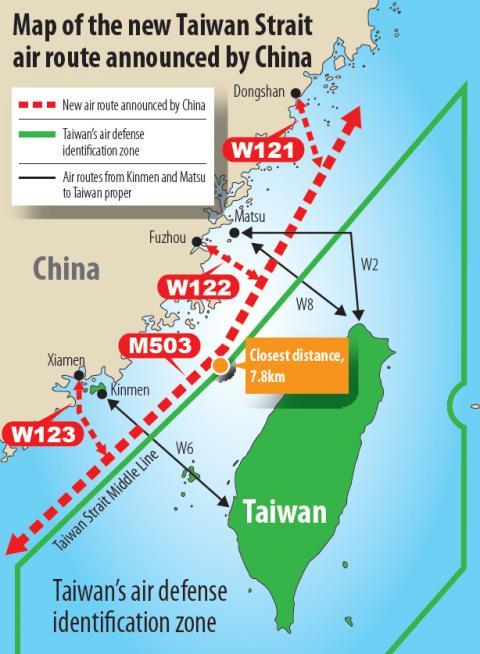The US Department of State has urged China and Taiwan to enter into dialogue to resolve flight route disputes across the Taiwan Strait after Beijing announced its unilateral decision to launch the W121 flight route over the weekend.
In a reply to CNA's inquiry, a US State Department spokesperson said Sunday that the US expected cross-Taiwan Strait differences to be resolved "by peaceful means, free from coercion, in a manner acceptable to the people on both sides of the Strait."

Photo: Taipei Times
The spokesperson said that the US stance related to cross-strait disputes was consistent.
"Issues related to civil aviation and safety in the Taiwan Strait should be decided through dialogue between both sides," the spokesperson said.
The statement from the US State Department was a response to China's unilateral announcement earlier Sunday that it would open the northwest-to-southeast W121 route connecting Dongshan in Zhejiang province to the north-south M503 flight route.
It was not the first time Beijing has acted unilaterally on establishing flight routes.
China moved the M503 route eastwards and closer to the median line of the Taiwan Strait in February last year, despite protests from Taiwan.
The M503 route, unilaterally declared by China in 2015, is located in the Shanghai Flight Information Region but very close to the Taipei Flight Information Region, raising concerns about flight safety and Taiwan's sovereignty.
After negotiations with Taiwan, when it was still governed by a Kuomintang (KMT) administration that favored better cross-Strait relations, China agreed to move the M503 route six nautical miles to the west of its original path.
However, Beijing announced on Jan. 30 last year that it was shifting the route eastward again, effective Feb. 1.
The opening of the W121 flight route comes after W122 and W123, two other west-to-east flight paths to the south of W121, were opened last year at the same time as the M503 route was moved eastward.
Michael Mazza, senior director for research of the Institute for Indo-Pacific Security, told CNA yesterday that the unilateral openings of the flight routes represented both symbolic and substantive actions from China.
In a symbolic way, Mazza said China wanted to use the launches to demonstrate sovereignty over the skies, hoping to make Taiwan feel isolated, as the International Civil Aviation Organization (ICAO) would not object.
Substantively, Mazza said, these routes posed a national security concern to Taiwan as they allow Chinese pilots who might be involved in future military action against Taiwan to familiarize themselves with routes over the Taiwan Strait.
He said China may use these routes to approach Taiwanese airspace without raising alarms by disguising military aircraft as civilian carriers.
"Overall, China's air route machinations are part and parcel of a broader effort to pressure, envelop and complicate the defense of Taiwan," Mazza said.

Beijing could eventually see a full amphibious invasion of Taiwan as the only "prudent" way to bring about unification, the US Department of Defense said in a newly released annual report to Congress. The Pentagon's "Annual Report to Congress: Military and Security Developments Involving the People's Republic of China 2025," was in many ways similar to last year’s report but reorganized the analysis of the options China has to take over Taiwan. Generally, according to the report, Chinese leaders view the People's Liberation Army's (PLA) capabilities for a Taiwan campaign as improving, but they remain uncertain about its readiness to successfully seize

Taiwan is getting a day off on Christmas for the first time in 25 years. The change comes after opposition parties passed a law earlier this year to add or restore five public holidays, including Constitution Day, which falls on today, Dec. 25. The day marks the 1947 adoption of the constitution of the Republic of China, as the government in Taipei is formally known. Back then the Chinese Nationalist Party (KMT) governed China from Nanjing. When the KMT, now an opposition party in Taiwan, passed the legislation on holidays, it said that they would help “commemorate the history of national development.” That

Taiwan has overtaken South Korea this year in per capita income for the first time in 23 years, IMF data showed. Per capita income is a nation’s GDP divided by the total population, used to compare average wealth levels across countries. Taiwan also beat Japan this year on per capita income, after surpassing it for the first time last year, US magazine Newsweek reported yesterday. Across Asia, Taiwan ranked fourth for per capita income at US$37,827 this year due to sustained economic growth, the report said. In the top three spots were Singapore, Macau and Hong Kong, it said. South

Snow fell on Yushan (Jade Mountain, 玉山) yesterday morning as a continental cold air mass sent temperatures below freezing on Taiwan’s tallest peak, the Central Weather Administration (CWA) said. Snowflakes were seen on Yushan’s north peak from 6:28am to 6:38am, but they did not fully cover the ground and no accumulation was recorded, the CWA said. As of 7:42am, the lowest temperature recorded across Taiwan was minus-5.5°C at Yushan’s Fengkou observatory and minus-4.7°C at the Yushan observatory, CWA data showed. On Hehuanshan (合歡山) in Nantou County, a low of 1.3°C was recorded at 6:39pm, when ice pellets fell at Songsyue Lodge (松雪樓), a